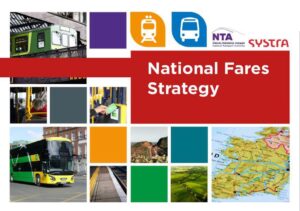 NTA has today published its National Fares Strategy for commuter and inter-urban journeys on Public Service Obligation (PSO) bus and rail services.
NTA has today published its National Fares Strategy for commuter and inter-urban journeys on Public Service Obligation (PSO) bus and rail services.
Fare decisions based on this Strategy will be determined and published at a later date.
Under this Strategy, changes introduced in future fares determinations will reflect a more consistent, equitable approach, and one that is easier to understand for customers.
This follows on from the successful implementation in 2021 of the 90-minute fare across Transport for Ireland services in the Dublin area, which allows passengers free transfer between Dublin Bus, Luas and most DART, commuter rail and Go-Ahead Ireland services in Dublin within 90 minutes of initial touch on.
Under a new National Fare Structure, the cost per kilometer travelled will be consistent across the country and will be related to the straight line distance between the origin and destination of journey. The fare for a bus journey of say 20km will be the same whether it takes place in the north-west or south-east. Currently this is not always the case.
Under this Structure, fares are to be made up of a combination of a boarding charge plus an incremental fare based on the distance of the journey. The boarding charge represents a fixed fee which is applied to the journey regardless of the distance. In addition, an incremental distance-based fare will be applied based on the straight line distance travelled. The standard National Fare Structure approach will apply to all trips across Ireland outside of the cities and main towns.
The Strategy published today includes a variation of this structure that will apply to fares in the Dublin area. The aim of this variation is to eliminate fare inconsistencies within the region.
In Dublin, a City Zone is to be introduced. This zone will extend approximately 23km from the city, and broadly equates to the existing 90-minute fare zone.
A new Outer Dublin Commuter Zone extending to approximately 50km from Dublin city centre will also be created. It will include towns such as Drogheda, Navan, Trim, Enfield, Clane, Prosperous, Newbridge, Kildare, Greystones and Wicklow. This area was selected based on a review of future public transport network proposals (e.g. the implementation of DART+) along with an analysis of ticket sales information to determine commuter travel demand.
While the Strategy does not propose changes to the Dublin City Zone fares, fares for journeys between Dublin and the Outer Dublin Commuter Zone will be reviewed and revised in upcoming determinations.
For travel from the Outer Dublin Commuter Zone into the Dublin City Zone (or vice-versa) the lower of the following fares will apply:
This will ensure that the cheapest fare is made available for passengers and will help alleviate boundary issues between the national and city fare structures.
For short distance trips crossing the Dublin City Zone boundary passengers will get the benefit of the National Fare Structure provisions and the associated lower fare reflective of the short distance travelled.
However, for longer distance journeys, passengers will benefit from the flat fare element within the city facilitating longer distances of travel at a cheaper fare.
Variations for other major cities and towns are to be developed as part of this Strategy.
The migration of current fares to the National Fare Structure is likely to be take place over a number of years, and will depend in part on upgrades to existing ticketing equipment and the procurement of next generation ticketing equipment, currently underway.
NTA hopes to implement revised fare structures in the Dublin commuter area as a priority.
For more information : The National Fares Strategy